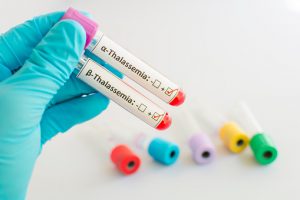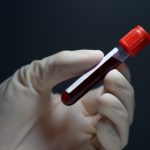
Thalassemia and sickle cell disease are both genetic disorders. Science tells us that they are caused by glitches in the genes that control hemoglobin. Hemoglobin is a red protein responsible for transporting oxygen in the blood. Normally, both parents need to have the abnormal gene in order for a child to have the disease. Sadly, these diseases can be serious and sometimes even fatal.
Thalassemia can occur when there is an abnormality in one of the genes involved in hemoglobin production. In someone with thalassemia, the body ends up producing less hemoglobin. When only one of your parents is a carrier for thalassemia, you can develop a form of the disease referred to as, “thalassemia minor.” In this case, you likely won’t experience any symptoms; however, you are still a carrier of the disease.
People who have sickle cell disease have a genetic mutation that causes an unusual form of hemoglobin known as “hemoglobin S”. This can cause anemia and pain.
Types of thalassemia

There are two alpha and two beta chains in each hemoglobin molecule. With thalassemia there are less than two chains of each type being produced.
The most common thalassemia is beta thalassemia. In patients with beta thalassemia, low levels of hemoglobin cause a lack of oxygen in many parts of the body. There is a form of beta thalassemia that causes moderate anemia so, in other words, thalassemia and sickle cell can go hand-in-hand. There is also a beta thalassemia called, Cooley’s Anemia that leads to severe anemia. In this case, a child must have frequent transfusions in order to survive.
The other common type of thalassemia, alpha thalassemia, is a blood disorder that takes place when one or more genes controlling the production of alpha hemoglobin is either defective or completely absent. If two people who lack one alpha gene have children, studies show that one in four of those children (on average) will inherit both mutations and will produce only one alpha chain in each molecule. Alpha thalassemia can cause mild anemia.
Signs and symptoms of thalassemia
Thalassemia symptoms are really dependent on the severity of the disease. People with alpha and beta thalassemia can experience anemia, but thalassemia anemia symptoms for those who fall under the beta category may be confusing because they often experience other health problems.
Here are some general thalassemia anemia symptoms:
- Fatigue
- Pale skin
- Cold hands and feet
- Shortness of breath
- Headaches
People with alpha thalassemia may also experience chest pain, drowsiness, and dizziness. The other thalassemia symptoms observed in beta patients include jaundice, delayed growth (in kids), skeletal deformities, excessive iron, increased infections, as well as delayed puberty.
Sickle cell disease and thalassemia
In the case of sickle cell anemia, red blood cells are not round – they are curved or look like a sickle, hence the name. Researchers discovered that this was due to a single amino acid error. Unfortunately, this error causes cells to clog up small blood vessels. These unusually shaped blood cells impair circulation and are destroyed quicker by the spleen than normal red blood cells. This can cause a large spleen and abdominal pain.
On the other hand, thalassemia produces normal shaped hemoglobin, but much less of it. In the late 1940’s doctors realized it was due to a problem in the structure of hemoglobin that causes thalassemia. Twenty years later, medical experts discovered that blood transfusions could alleviate most of the childhood symptoms of thalassemia anemia, which led to an increase in survival rates.
Treatment options for thalassemia
Treatment for thalassemia is customized based on the type and severity of the disease. As mentioned above, in extreme cases, blood transfusions may be required. Below are some other options doctors may have to consider:
- Medications
- Supplements
- Bone marrow transplant
- Surgery
If surgery is needed, it is usually to remove the spleen or the gallbladder. When it comes to supplements, iron is most frequently recommended. People who receive blood transfusions get extra iron that the body has difficulty getting rid of. Since iron accumulation can be fatal, there is a therapy to help remove it from the body. It is commonly referred to as “iron chelation.”
Healthy living with thalassemia
People with thalassemia can get infections, especially in cases where the spleen has been removed. A fever could be a sign of infection, so those with the disease should be aware of that. Getting vaccinations may prevent some people with thalassemia from getting infections.
Maintaining a diet with all the essential nutrients and having a diet that is low in fats is also advisable. Since too much iron can build-up in people with thalassemia, a diet high in iron should be avoided. Your doctor might recommend a folic acid supplement to help your body make new red blood cells as well.
Although vigorous exercise can be difficult for some people who suffer from thalassemia, especially those who experience a lot of pain, lighter exercise, such as walking, swimming, and cycling can be helpful.
Sickle cell disease impacts about 90 to 100,000 Americans, according to the Centers for Disease Control and Prevention (CDC). Research hints that thalassemia is a lot less common, but up-to-date statistics are not available. We can tell you that the disorder tends to occur among certain ethnicities. As an example, a study published in BMC Public Health suggests that 4.5 to 6 percent of the Malaysian and Chinese population carries the genetic disorder.